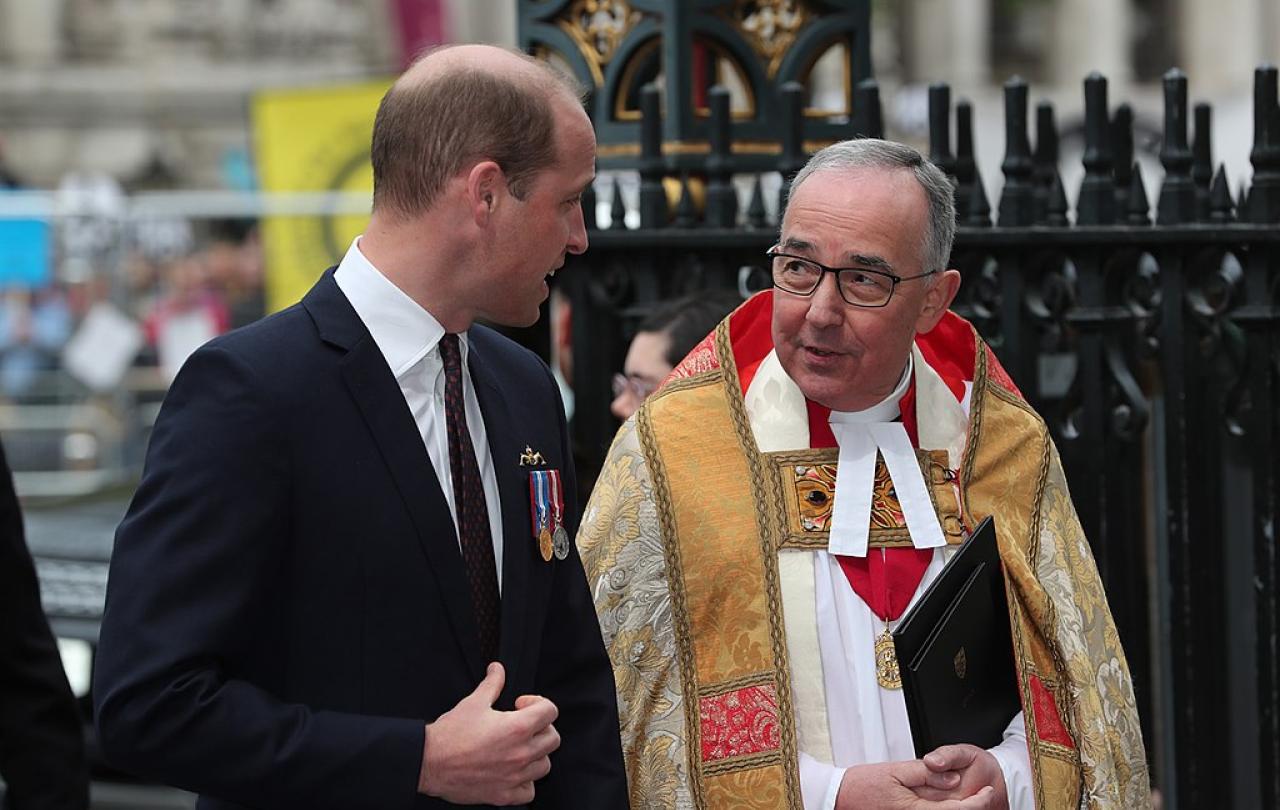
A new book, serialised in the Daily Mail, suggests Prince William is wondering whether he really wants to be Supreme Governor of the Church of England. While he respects the Church, it claims, he doesn’t consider himself particularly religious and doubts if he should head up a church he doesn’t attend much. There has been a fair amount of comment on the contrast between his grandmother’s strong Christian faith, increasingly evident in her Christmas broadcasts as she came to the end of her life, and that of his father, who has also made a point since his accession to the throne of emphasising his own personal Christian commitment, both in statements around the time he became king, and in his Christmas broadcast this past year.
William, however, is less forthcoming. He was dutifully confirmed at Eton at the age of 14, and goes to church at Christmas and Easter, so presumably is not a hardened Dawkins-esque atheist. Like many of his generation he probably has his doubts about God and religion, doesn't often speak publicly about faith and so it's hard to know from the outside whether this really is a motivating force in his life or not.
Of course, there is a whole separate argument about why personal faith, while it helps, is not strictly necessary for such a role. Many British monarchs in the past have not had a very strong Christian faith. The significance of the role rests in the office not the person - it is a constitutional not a personal, arrangement. But that is a different story. What interests me is what this story tells us about faith and doubt and the experience of what it is to believe.
Like in my atheist days, I have days when I wake up and wonder whether it's all true. Am I deceiving myself?
I was once an atheist. Yet, like most atheists, I had my doubts. I tried to get on with my life not believing in God, yet every now and again something would happen to make me doubt my atheism. I would meet a Christian with a profoundly impressive life motivated by their faith and it disturbed me. An argument from a Christian writer momentarily seemed strangely plausible. An encounter of the beauty and wonder of nature suddenly might lodge the thought in my mind that maybe there is a Creator after all? Like all good atheists, however, I managed to push these thoughts to the back of my mind. I learn to doubt and resist these impulses and return to my central take on the world which was that there definitely is no God.
As it happened, in time, my doubts became too strong for me, and I began to think that Christian faith made more sense of the world than atheism did. And so, eventually and slowly, I became a Christian. Of course, the process happens the other way around as well. People with a notional Christian faith start to doubt it to the extent that it no longer makes sense to them.
I have now been a Christian for many years and a Bishop for a few of those. Like in my atheist days, I have days when I wake up and wonder whether it's all true. Am I deceiving myself? Have I wasted most of my life on something that is not real? I might read a book that is sceptical about some aspect of the Christian story and a doubt niggles away in the back of my mind. God suddenly appears silent in answer to heartfelt prayers, and for a moment I wonder if he is there at all. I have doubts, just as I did in my atheist days.
But just like I did when I was an atheist, I learned to doubt my doubts. Atheists often challenge Christians to come up with a piece of evidence that would suggest that God exists. And sometimes we try, with arguments from the design of the universe, apparent miracles, fulfilment of biblical prophecies and so on. But they never quite convince. The reason they don't convince is that the atheist can always come up with an alternative explanation. And that takes us to the heart of the issue.
For Christians, and for other believers in God for that matter, God is not another object in the universe that can be proved or disproved. I might find indications that point in the direction of there being a God but, as the atheist points out, you can always explain them away in some form or other.
Instead, atheism and belief in God are better seen, not as the result of a process of sifting evidence, looking for proof one way or another, but as different ways of looking at the world.

The philosopher Ludwig Wittgenstein once picked up a common cartoon that circulated in German comic newspapers in the late nineteenth century to make a similar point. Looked at one way, it looks like a rabbit. Look at it another way it looks like a duck. Whether you see a rabbit or a duck is dependent upon other factors. Children who have just been to the local duckpond might be inclined to see a duck. Someone with a pet rabbit might be inclined to see a rabbit. Wittgenstein’s point was about the way concepts in our mind shape our perceptions of reality. We may perceive the same thing, but we see it as something different.
This idea of ‘seeing as’ – seeing something not just in itself, but ‘as’ something shaped by our mind’s perceptions, became well known in philosophy after Wittgenstein’s use of the image. It may help us in thinking about belief in God as well.
On a Christmas Day edition of ‘The Rest is Politics’ with Alistair Campbell and Rory Stewart (soon after his appearance on Re-Enchanting’), two of the most popular podcasts of our times met when Tom Holland of ‘The Rest is History’ came on the podcast. As it was Christmas Day, Alistair Campbell asked Tom Holland whether he believed the Christmas story and all the rest of the Bible. His reply referred to this very picture of the duck / rabbit, and he said: “There are times where I can believe it, and there are other times where I look at the stories and think this is absolutely ridiculous - how could it possibly be true? I think the Infinity of space, I think of vast geological time and I think it's absolutely nonsense. So I kind of veer between the two.”
In a way he’s right. You can’t decide between the two ways of looking at the picture by some process of forensic scientific evidence. There is no ultimate way of deciding whether it is a duck or a rabbit.
Now the analogy with faith is imperfect. The picture could be a rabbit, it could be a duck. Whereas, to put it bluntly - there either is or is not a God – both can’t be true. Where the image helps us, is that in our limited understanding of things it is impossible for any of us to say, whether believer or atheist, that we know 100 per cent definitively that there is or is not a God. Even Richard Dawkins agrees on that point!
The other difference is that you can’t be neutral on this. Whether you see it as a duck or a rabbit probably makes no difference to your life. Yet faith is more than just an opinion. It is a way of life. To ‘believe’ in God, in the Christian sense of ‘believe’ is not just to hold the opinion in your head that God exists, but to decide to live as if it true that God exists, that he is revealed in Jesus Christ, that each person you meet each day is a precious soul, for whom Jesus died and so on.
The American philosopher Michael Novak put it like this:
“The centre of the argument concerns whether I should think of the universe as impersonal and indifferent to me, and ruled by randomness and chance. Or whether I should interpret it as personal through and through, in such a way that all things that are and have been and will be dwell in the presence of God a person who understands and chooses all that he brings out of nothingness into existence.”
Whatever faith position you take up - to believe that there is a God or that there isn't, you will have doubts. But the nature of faith is not to have an absence of doubt, but it's how you treat those doubts. At the end of the day, each of us has to decide which approach makes most sense of the world that we experience every day. Does the problem of Evil – why bad things sometimes happen - mean you can’t believe in God? Or does the problem of Good – why good things sometimes happen – mean you can’t be an atheist?
Prince William, and Tom Holland for that matter may have their doubts about faith, But that is no reason not to decide to believe.
When I became a Christian it was because the world no longer made sense to me as a place that emerged by chance, that has no ultimate purpose, that our intelligence emerged literally from non-sense. Our deep need for love seemed to fit better with the idea that this world emerged out of love, than that it emerged from a heartless, random void. Seeing the world in that way makes better sense to me than the alternative. It doesn't mean everything suddenly makes sense, but it does offer me a better way of thinking and living in the world. I can't prove it. I have my days of doubt. But that's the way I choose to believe, and choose to live.





